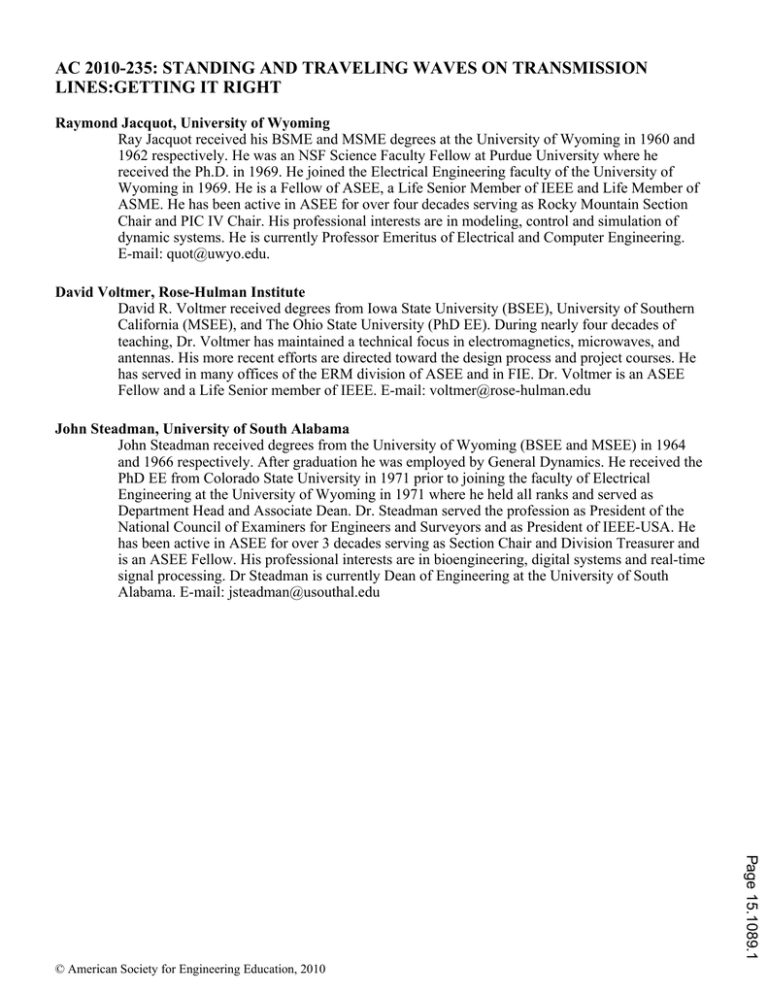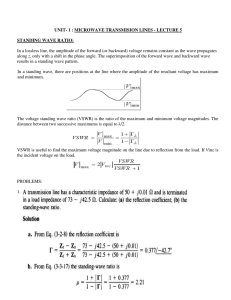Standing And Traveling Waves On Transmission Lines:Getting It Right
advertisement

AC 2010-235: STANDING AND TRAVELING WAVES ON TRANSMISSION
LINES:GETTING IT RIGHT
Raymond Jacquot, University of Wyoming
Ray Jacquot received his BSME and MSME degrees at the University of Wyoming in 1960 and
1962 respectively. He was an NSF Science Faculty Fellow at Purdue University where he
received the Ph.D. in 1969. He joined the Electrical Engineering faculty of the University of
Wyoming in 1969. He is a Fellow of ASEE, a Life Senior Member of IEEE and Life Member of
ASME. He has been active in ASEE for over four decades serving as Rocky Mountain Section
Chair and PIC IV Chair. His professional interests are in modeling, control and simulation of
dynamic systems. He is currently Professor Emeritus of Electrical and Computer Engineering.
E-mail: quot@uwyo.edu.
David Voltmer, Rose-Hulman Institute
David R. Voltmer received degrees from Iowa State University (BSEE), University of Southern
California (MSEE), and The Ohio State University (PhD EE). During nearly four decades of
teaching, Dr. Voltmer has maintained a technical focus in electromagnetics, microwaves, and
antennas. His more recent efforts are directed toward the design process and project courses. He
has served in many offices of the ERM division of ASEE and in FIE. Dr. Voltmer is an ASEE
Fellow and a Life Senior member of IEEE. E-mail: voltmer@rose-hulman.edu
John Steadman, University of South Alabama
John Steadman received degrees from the University of Wyoming (BSEE and MSEE) in 1964
and 1966 respectively. After graduation he was employed by General Dynamics. He received the
PhD EE from Colorado State University in 1971 prior to joining the faculty of Electrical
Engineering at the University of Wyoming in 1971 where he held all ranks and served as
Department Head and Associate Dean. Dr. Steadman served the profession as President of the
National Council of Examiners for Engineers and Surveyors and as President of IEEE-USA. He
has been active in ASEE for over 3 decades serving as Section Chair and Division Treasurer and
is an ASEE Fellow. His professional interests are in bioengineering, digital systems and real-time
signal processing. Dr Steadman is currently Dean of Engineering at the University of South
Alabama. E-mail: jsteadman@usouthal.edu
Page 15.1089.1
© American Society for Engineering Education, 2010
Standing and Traveling Waves on Transmission Lines: Getting it Right
Introduction
In the recent engineering education literature there have been numerous papers dealing with
strategies for teaching electrical transmission lines. These papers approach the assistance in
teaching from two points of view. The first is the use of simple low-cost experiments to
demonstrate the concepts 1-3 and the second approach employs computer animation 4, 5. Another
recent paper discusses the concept of teaching transmission lines early in the electromagnetics
sequence 6.
Seeking clarification to the problem of sinusoidally driven, arbitrarily terminated, lossless
transmission lines one of the authors asked the question, “How does the voltage on the line
behave?” In order to answer this question some MATLABTM scripts were written to animate the
voltage on the line. In examining these animations more questions arose about the concept of
standing waves. In the examination of the animations the authors were confounded because for
arbitrary termination impedance the resulting waveform did not “stand” as is the case for the
commonly discussed short-circuit and open-circuit terminations. Consultation of a number of
electromagnetics textbooks found that the term “standing wave” is often used to describe the
interference pattern created by a combination of forward and backward traveling waves of the
same wavelength (or frequency). As we shall show this definition is incomplete and leads to a
semantic error in a number of contemporary textbooks.
Standing or Stationary Waves
After the search of electromagnetics textbooks it was decided to look on the web for information
which is contained on physics websites. Standing waves are created by the addition of two
oppositely traveling waves of equal wavelength and amplitude. There seems to be an agreement
that the terms standing waves and stationary waves are synonymous and that such waves are
characterized by nodes (points of zero response) and antinodes (points of maximum response)
and that there is no energy transport in the direction of propagation 7.
A final resolution to the definition problem came with a search of Lord Rayleigh’s 1891 edition
of The Theory of Sound 8 wherein the above stated definition was confirmed. The Rayleigh
definition essentially states that sinusoidal waves are stationary (standing) if they are of the form
w( z ,t ) = P cos( ωt - ε ) cos( βz - α )
(1)
or after employing the appropriate trigonometric identity
P
w( z , t ) = [cos( ωt + βz - ε - α ) + cos( ωt - βz - ε + α )]
(2)
2
We see that expression (2) is the sum of forward and backward traveling waves each of
amplitude P/2. A similar result may be found in the handbook of Korn and Korn 9.
Page 15.1089.2
Some Transmission Line Theory
Consider the lossless transmission line illustrated in Figure 1 with source impedance Zg and
terminal impedance ZL.
Zg
L’, C’, up, Z0
Vg
Vin
z = -L
ZL
V(z)
VL
z=0
Figure 1. Lossless Transmission Driven by a Sinusoidal Source.
The steady-state sinusoidal voltage and current on the line are governed by the phasor form of
the telegrapher’s equations or
dV
? / jψL' I
(3)
dz
and
dI
? / jψC' V
(4)
dz
where L’ and C’ are the respective per unit length inductance and capacitance and V(z) and I(z)
are the phasor voltage and current as functions of location. The characteristic impedance of the
line is Z0 = L' / C' and the propagation velocity u p ? 1 / L' C' .
The solution for the phasor voltage on the line after application of the terminal boundary
condition is
V ( z ) ? V0− [ e / jδz − Ιe jδz ]
(5)
In general V0− is complex and can be written as V0− e jη so V(z) is
Page 15.1089.3
where δ ? ψ L' C' and Ι is the complex reflection coefficient defined by
Z / Z0
Ι ? L
? Ι e j 2σ
(6)
Z L − Z0
In some of the engineering education literature the interference pattern given by calculation of
the magnitude of (5) for any nonzero value of Ι is termed a standing wave. As will now be
shown this solution of expression (5) does not, in general, result in a standing wave. Using the
polar form for Ι , V(z) may be written as
V ( z ) ? V0− e jσ [ e / j( δz −σ ) − Ι e j( δz −σ ) ]
(7)
For any general termination expression (5) may be rewritten as
V ( z ) ? V0− e jσ { Ι [ e / j( δz −σ ) − e j( δz −σ ) ] − ( 1 / Ι )e / j( δz −σ ) }
(8)
V ( z ) ? V0− e j( η −σ ) { Ι [ e / j ( δz −σ ) − e j( δz −σ ) ] − ( 1 / Ι )e / j ( δz −σ ) }
(9)
and the resulting time domain solution is
v( z ,t ) ? V0− }2 Ι cos( δ z − σ ) cos( ψt − η − σ ) − ( 1 / Ι ) cos( ψt / δ z − η )ϒ
(10)
The first term is a standing wave as defined by Rayleigh in expression (1) and the second term a
forward traveling wave and clearly the general solution to this problem is not simply a standing
wave as purported in some of the textbook literature but rather a superposition of both a standing
wave and a forward traveling wave. It appears that this semantic error has been in the textbook
literature for at least half a century or perhaps much longer.
If Ι ? 1 then relation (10) becomes
v( z ,t ) ? 2 V0− cos( δ z − σ ) cos( ψt − η − σ )
(11)
which is a standing wave as defined by Rayleigh.8 From relation (6) it is easy to see that the
only way for Ι ? 1 is for ZL to be zero, infinity or imaginary (reactive).
If Ι ? 0 then the solution becomes
v( z ,t ) ? V0− cos( ψt / δ z − η )
(12)
which is a forward traveling wave. An expression similar to (10) for the current on the line can
be developed and then both can be evaluated at z = 0 and then the average power at the load may
be evaluated and we can see that this power is transmitted to the load by only the forward
traveling wave portions of the voltage and current expressions.
There are several misnomers that persist as a result of this semantic problem. The first is the
term the standing wave diagram which is given by plotting the magnitude of either relation (5) or
(9) as a function of z regardless of the value of Γ . This might better be referred to as the
amplitude diagram since it represents the voltage amplitude along the line. The standing wave
ratio is the other misnomer and is the ratio of the maximum to the minimum of the so called
standing wave diagram.
An Example
Consider the lossless line with the following parameter values
Z0 = 300 Ω
L = 5200 m
Zg= 300 Ω
up = 2x108 m/s
f = 105 Hz
Vg = 1 ∟0° V
We shall examine what happens as we vary the load impedance ZL by considering three cases:
1) ZL = ∞ (open circuit termination, Γ = 1 ), 2) ZL = 300 Ω (the matched case, Γ = 0 ) and 3) ZL
= 500 Ω (the arbitrary unmatched case, Γ = 0.25 ).
Case 1 ZL = ∞ (Open Circuit Termination)
The voltage on the line is shown in Figure 2 for 10 values of time over one temporal period. In
this case the voltage on the line is a standing wave with the associated nodes and antinodes.
Page 15.1089.4
Press Enter to Animate
1
0.8
Line Voltage, v(z,t)
0.6
0.4
0.2
0
-0.2
-0.4
-0.6
-0.8
-1
ψΦt = ρ/5 (10 samples per temporal cycle)
-1
-0.8
-0.6
-0.4
-0.2
0
Dimensionless Distance on the Line, z/L
0.2
Figure 2. Standing Waves on Transmission Line with Open Circuit Termination,
Z0 = 300 Ω, ZL = ∞ Ω.
.
Case 2 ZL = 300 Ω (Matched Termination)
Figure 3 illustrates the line voltage for the case where the terminal impedance is matched to the
characteristic impedance of the line (300 Ω). This is a forward traveling wave with an amplitude
of 0.5 volts
Press Enter to Animate
0.5
0.4
Line Voltage, v(z,t)
0.3
0.2
0.1
0
-0.1
-0.2
-0.3
-0.4
-0.5
ψΦt = ρ/5 (10 samples per temporal cycle)
-1
-0.8
-0.6
-0.4
-0.2
0
Dimensionless Distance on the Line, z/L
0.2
.
Figure 3. Traveling Voltage Waves for a Terminal Impedance Matched to the Line,
Z0 = ZL = 300 Ω.
.
Page 15.1089.5
Case 3 ZL = 500 Ω (Arbitrary Unmatched Termination)
Figure 4 illustrates the voltage on the line for a mismatched load impedance. The traveling wave
nature can be seen clearly superimposed over the standing wave. There are no nodes in this case
as opposed to those shown in Figure 2. The solution is neither a pure standing wave nor a pure
traveling wave but a combination of the two.
Press Enter to Animate
0.6
Line Voltage, v(z,t)
0.4
0.2
0
-0.2
-0.4
-0.6
ψΦt = ρ/5 (10 samples per temporal cycle)
-1
-0.8
-0.6
-0.4
-0.2
0
Dimensionless Distance on the Line, z/L
0.2
Figure 4. Forward Traveling and Standing Voltage Wave for an Unmatched Termination,
Z0 = 300 Ω, ZL = 500 Ω.
For the case of a short circuit termination or a reactive termination the magnitude of the
reflection coefficient is unity and the voltage waveform on the line is similar to that of Figure 2.
Conclusion
The authors have shown that the only when a lossless transmission line is terminated by a load
without energy dissipation can standing waves alone develop on the line. In any other case the
waves on the line are a combination of a standing and a forward traveling wave.
In the process of exploring animation of the transmission line problem the first author became
interested in how animation might clarify the teaching of other concepts described by partial
differential equations. As a result more than fifty scripts were developed to animate problems in
heat conduction, beam and string vibration, groundwater transport, wave propagation and fluid
dynamics. The interested reader can access all these MATLABTM scripts for animation at the
website http://www.eng.uwyo.edu/classes/matlabanimate
References
Page 15.1089.6
1. Jalali, Transmission Line Experiments at Low Cost, Proc. 1998 ASEE Annual Conference and
Exposition, Seattle, WA, June 28-July 1, 1998, Session 2648.
2. D.M. Hata, A Low-Cost Approach to Teaching Transmission Line Fundamentals and Impedance
Matching, Proc. 2004 ASEE Annual Conference and Exposition, Salt Lake City, UT, June 20-23, 2004,
Session 1526.
3. A. Rusek and B. Oakley, Easy-to-do Transmission Line Demonstrations of Sinusoidal Standing Waves
and Transient Pulse Reflections, Proc. 2007 ASEE Annual Conference and Exposition, Honolulu, HI,
June 24-27, 2007, Session 3532.
4. C.W. Trueman, Teaching Transmission Line Transients Using Computer Animation, Proc. ASEE/IEEE
Frontiers in Education Conference, San Juan, Puerto Rico, Nov. 10-13, 1999, Session 12a9.
5. R. G. Jacquot, C.H.G. Wright and R.F. Kubichek, Animation Software for Teaching Electrical
Transmission Lines, Proc. 2006 ASEE Annual Conference and Exposition, Chicago IL, June 18-21,
2006, Session 1120.
6. S.H. Mousavinezhad, Electric and Magnetic Fields, Transmission Lines First?, Proc.2006 ASEE Annual
Conference and Exposition, Chicago, IL, June 18-21, 2006, Session 3232.
7. www.citycollege.com/standing_wavesXIa.htm
8. J.W. Strutt, Third Baron Rayleigh, The Theory of Sound: Volume 1, Dover, New York, NY,1945.
9. G.A. Korn and T. M. Korn, Mathematical Handbook for Scientists and Engineers: Second Edition,
McGraw-Hill, 1968.
Page 15.1089.7




